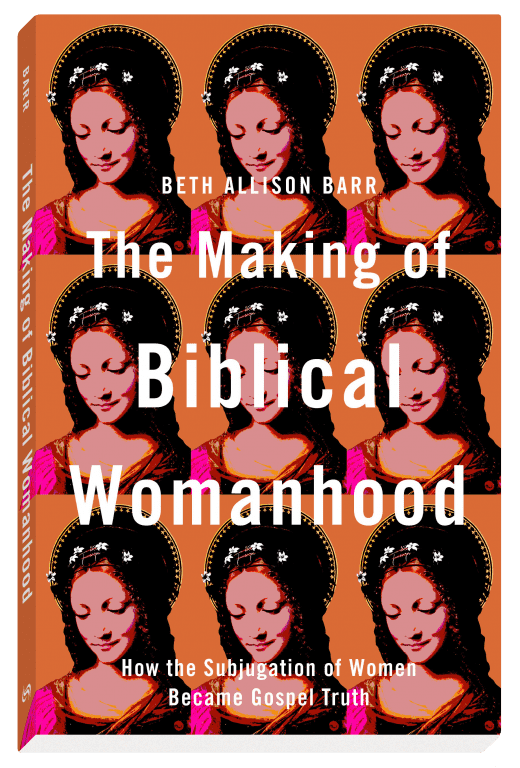In less than 5 weeks, The Making of Biblical Womanhood: How the Subjugation of Women Became Gospel Truth will be published. My writing on the Anxious Bench birthed this book, and so I thought it appropriate for the Anxious Bench to be the first public space to host the introduction. I am thankful for Brazos Press allowing me to do this. So here’s the moment I decided to take on Christian patriarchy.
–And thanks to all my Anxious Bench readers who have walked with me on this journey.
Beth Allison Barr, PhD
 I never meant to be an activist.
I never meant to be an activist.
My Southern Baptist world of small-town Texas preached the divinely ordained roles of women. In everything from sermons to Sunday school lessons to advice from well- meaning teachers, women were called to secondary roles in church and family, with an emphasis on marriage and children. Once, I remember hearing a woman speak from behind our church pulpit. She was single, a missionary, and—an adult explained to me—only describing her experiences. This rationalization just reinforced her strangeness. A single woman behind the pulpit was aberrant; married women behind their husbands were the norm.
James Dobson was everywhere, filling even the airwaves with his regular radio broadcast. As a teenager, I remember flipping through his book Love for a Lifetime. I learned that biology predetermined my physical weakness and emotional instability, drawing me to my divinely created masculine complement. Dobson wrote to strengthen marriages, offering help to spouses, who are pulled apart by their natural differences: “Show me a quiet, reserved husband and I’ll show you a frustrated wife,” he wrote. “She wants to know what he’s thinking and what happened at his office and how he sees the children, and especially, how he feels about her. The husband, by contrast, finds some things better left unsaid. It is a classic struggle.” In just a few sentences, Dobson impressed upon me the shape of the normal Christian household—a father returning from his office job to the home front managed by his wife and children.
Select biblical passages, undergirded by the notes in my study Bible, were woven through sermons, Bible studies, and devotionals, creating a seamless picture of scriptural support for female subordination. Women were made to desire their husbands and let them rule (Genesis); women were to trust God and wait for their perfect husband (Ruth); men’s voices were public, while women’s voices were private (1 Corinthians; 1 Timothy); when women did take charge, it was either sinful (Eve) or because men had failed to do their jobs (Deborah). A woman’s position was supportive and secondary, unless she had to temporarily step into leadership when men could not.
This was my understanding of biblical womanhood: God designed women primarily to be submissive wives, virtuous mothers, and joyful homemakers. God designed men to lead in the home as husbands and fathers, as well as in church as pastors, elders, and deacons. I believed that this gender hierarchy was divinely ordained. Elisabeth Elliot famously wrote that femininity receives. Women surrender, help, and respond while husbands provide, protect, and initiate. A biblical woman is a submissive woman.
This was my world for more than forty years.
Until, one day, it wasn’t.
On that day, I left church because I couldn’t take it anymore. More than three months prior, on September 19, 2016—the same hour my first doctoral student was orally defending her qualifying exams and dissertation prospectus—my husband was fired from his job as a youth pastor. He had served in the role for more than twenty years, fourteen in this church alone. Suddenly, quietly, painfully, he was told to walk away with a month of severance pay. Some friends, to whom we will forever be grateful, learned what happened and fought for us. They were able to delay the job loss for three months, enough for us to prepare the youth and transition the ministry; they also secured us an additional five months of severance pay. They gave us space to breathe.
The day I walked out of church, a Sunday in December almost three months later, the enormity of what was happening to us had finally become real.
I stood in front of a table someone had set up in the foyer. It had a picture of my family, with a little box on one side and a framed statement on the other. I don’t remember what the framed statement said—maybe a Scripture verse or something about the church being grateful for our ministry. Markers lay beside a stack of paper. People could write notes of farewell and tuck them inside the box.
I know the majority of people who wrote us notes were sincere. Most were genuinely sorry to see us go, bewildered by the circumstances. Some were upset and angry. Some were shaken by the church’s lack of transparency. Some were sadly anticipating the loss of our close friendship. For the words left by these people, sincere in their goodbyes, I am thankful.
But I don’t think the spirit behind the box, the reason the table was set up, was just for these people. It was about keeping up appearances. The carefully constructed table controlled the narrative about my husband’s and my departure. It helped convey that our leaving was a good decision made by shepherds caring for their flock. After all, providing a public forum to say goodbye was what you did when pastors left. When they left for new jobs or to go back to school or to become missionaries.
Yet what was happening to us was none of those things.
My husband was fired after he challenged church leadership over the issue of women in ministry.
Images crowded into my head. The text I received from my husband on September 19: “The meeting did not go well.” The brokenness and confusion of our youth workers, who were pushed out of serving in youth ministry because of their friendship with us. The faces of the youth that awful night, when we were forced to tell them we were leaving without telling them the full truth. The shadows of the elders standing guard around the room, watching as we told the youth we were leaving. The gut-wrenching tears of my son when he learned that he would never be in his father’s youth group. The dark garden in Virginia where I walked around and around and around one night, barely suppressing anxiety while my role as conference organizer left my husband alone in Texas to face one of his hardest weeks ever.
I could feel the raw edges of grief, anger, and righteous indignation rising inside me.
So I left. I walked straight out the church doors. Past the people standing in the foyer, including those who had been talking to me next to that table. Past one of the elders who tried to speak to me. I walked out the church doors and straight to my car. I left behind that table and its carefully constructed story. I left behind the narrative, propagated by my mostly upper-middle-class, white church, that all was well and that all would be well because God had ordained it so. I drove straight home.
Then I opened my laptop and started writing.
The words just flowed.
Different pieces of my life snapping together, sharpening into focus.
For all my adult life, I had served in ministry with my husband, remaining in complementarian churches even as I grew more and more skeptical that “biblical womanhood” as we had been taught matched what the Bible taught. I kept telling myself that maybe things would change—that I, as a woman who taught and had a career, was setting a positive example. I kept telling myself that complementarianism (the theological view that women are divinely created as helpers and men are divinely created as leaders) wasn’t at its root misogynistic. I kept telling myself that no church was perfect and that the best way to change a system was by working from within it. So I stayed in the system, and I stayed silent.
I stayed silent when a woman who worked at a Southern Baptist church and attended seminary alongside my husband was paid less by that church because she wasn’t ordained. Ironically, the reason she wasn’t ordained was because the church was Southern Baptist.
I stayed silent when a newly married woman whose job carried the family insurance quit that job after attending a retreat with women from our church—a retreat that featured a hard-line complementarian speaker who convinced this woman that her proper place was in the home. Her decision, from what I heard, caused tension within the family, including financial. She stopped coming to church. I have no idea what happened to her.
I stayed silent when, after our pastor preached a sermon on gender roles, a married couple gave their testimony. The wife encouraged women to verbally agree to what their husbands suggested, even if they really disagreed. God would honor their submission.
I stayed silent when I wasn’t allowed to teach youth Sunday school because the class included teenage boys. I led discussions with special permission when no one else was available.
I stayed silent.
It wasn’t until that Sunday, three months after the worst had happened, that I realized the hard truth. By staying silent, I had become part of the problem.
Instead of making a difference, I had become complicit in a system that used the name of Jesus to oppress and harm women.
And the hardest truth of all was that I bore greater responsibility than most in our church because I had known that complementarian theology was wrong.
Staring at that little table, I realized that most people in our church knew only the theological views that the leaders were telling them. Just like I heard only one narrative of biblical womanhood in church, many evangelicals in complementarian churches know only what they are told—what they are taught in seminary, what they read in the notes of their English Bible translations, what they learn in Sunday school about church history from history books written by pastors, not historians.
My anguish that morning stemmed from my shame as much as from my grief.
You see, I knew that complementarian theology—biblical womanhood—was wrong. I knew that it was based on a handful of verses read apart from their historical context and used as a lens to interpret the rest of the Bible. The tail wags the dog, as Ben Witherington once commented—meaning that cultural assumptions and practices regarding womanhood are read into the biblical text, rather than the biblical text being read within its own historical and cultural context. So much textual and historical evidence counters the complementarian model of biblical womanhood and the theology behind it. Sometimes I am dumbfounded that this is a battle we are still fighting.
As a historian, I also knew that women have been fighting against oppression from the beginning of civilization. I knew that biblical womanhood, rather than looking like the freedom offered by Jesus and proclaimed by Paul, looks much more like the non-Christian systems of female oppression that I teach my students about when we discuss the ancient worlds of Mesopotamia and Greece. As Christians we are called to be different from the world. Yet in our treatment of women, we often look just like everyone else. Ironically, complementarian theology claims it is defending a plain and natural interpretation of the Bible while really defending an interpretation that has been corrupted by our sinful human drive to dominate others and build hierarchies of power and oppression. I can’t think of anything less Christlike than hierarchies like these.
As I looked at my laptop screen, grappling with why that table in the foyer had upset me so much, I realized the hard truth about why I had stayed in complementarian churches for so long.
Because I was comfortable.
Because I really thought I could make a difference.
Because I feared my husband would lose his job.
Because I feared disrupting the lives of my children.
Because I loved the life of youth ministry.
Because I loved my friends.
So for the sake of the youth we served; for the sake of the difference my husband made in his job; for the sake of financial security; for the sake of our friends whom we had loved, laughed, and lived life with; and for the sake of our comfort, I chose to stay and to stay silent.
I had good reasons. But I was wrong.
I had become like those who knew about former seminary president Paige Patterson’s counsel to an alleged rape survivor, telling her to not report the crime and to forgive her rapist. Instead of speaking out, they stayed silent and allowed him to remain in power. I had become like those in Rachael Denhollander’s church who resisted her advocacy. Instead of defending her when she alleged cover-up of sexual abuse by Sovereign Grace Churches, a ministry group that her church was affiliated with, her church family turned away from her. As she said in her impact statement, “My advocacy for sexual assault victims, something I cherished, cost me my church and our closest friends.” I had become like the members of Andy Savage’s church who, in response to his confession of sexual assault as a former youth pastor, gave him a standing ovation. I had become like the members of Mark Driscoll’s church who listened, Sunday after Sunday, as he preached misogyny and toxic masculinity from the pulpit. I had become like so many well-meaning church members who have counseled women to forgive their rapists while simultaneously teaching female culpability in rape. While the blame for abuse lies primarily with the abuser, those who stand by and do nothing share in the blame too. Silent Christians like me have allowed both misogyny and abuse to run rampant in the church. We have allowed teachings to remain intact that oppress women and stand contrary to everything Jesus did and taught.
My husband, while preaching a sermon on integrity, drew an example from the 1994 movie Quiz Show. The main character, Charles Van Doren, allows himself to be corrupted by fame and success. He cheats to win the quiz show, week after week. When his deception is finally exposed and he has to confess to his father what he has done, his father, a respected professor at Columbia University, confronts him with these powerful words: “Your name is mine!” By allowing himself to be complicit in a corrupt system, Charles Van Doren had shamed not only himself but also his father.
“Your name is mine!”
Because I am a Christian, because I carry the name of Christ, his name is my name. Christians like Paige Patterson are guilty for what they have done. But because Patterson did it in the name of Jesus, and because fellow Christians stayed silent, his guilt is our guilt too. I knew this.
And that morning my tears confessed my guilt before God.
I made a decision, there in front of my laptop screen. Because my hope is in Jesus, I wasn’t going to give up on his church. I walked out of my church that day, but I wasn’t walking away from the church itself.
I wasn’t giving up.
This meant I could no longer keep what I knew to myself.
This book is my story.
It is the truth I have gleaned from my study of the Bible, from my experiences as a pastor’s wife, and from my training as a historian whose research focuses on women in medieval and early modern church history.
This book is for the people in my evangelical world. The women and men I still know and love. It is to you I am speaking. And it is you who I am asking to listen.
Listen not just to my experiences but also to the evidence I present as a historian. I am a historian who believes in the birth, death, and resurrection of Jesus. A historian who still identifies with the evangelical tradition—as a Baptist.
I confess it was experiences in my life, my personal exposure to the ugliness and trauma inflicted by complementarian systems in the name of Jesus, that tipped me over the edge. I can no longer watch silently as gender hierarchies oppress and damage both women and men in the name of Jesus. But what brought me to this edge was not experience; it was historical evidence. It was historical evidence that showed me how biblical womanhood was constructed—brick by brick, century by century.
This is what changed my mind.
Maybe it will change yours too.
Content taken from The Making of Biblical Womanhood: How the Subjugation of Women Became Gospel Truth by Beth Allison Barr, ©2021. Used by permission of Brazos, a division of Baker Publishing Group www.bakerpublishinggroup.com. Notes published in the text.

















